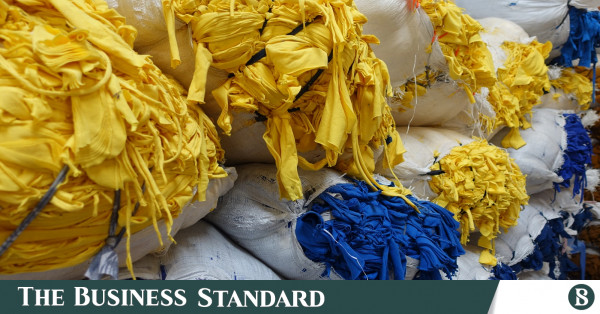Reverse Resources: Turning textile waste into raw material
GoogleAds

Reverse Resources is a Software as a Service (SaaS) platform with a mission to help the industry use its secondary resources as new raw material and thereby reduce its dependency on virgin materials on a large scale
For the last three years, Simco Spinning and Textiles Ltd. has been recycling 200 tonnes of textile waste materials every month.
In place of using virgin material (unused raw material), it uses 95 percent recycled material in its production. Simcon collects its textile waste for a particular buyer, recycles them for that buyer and upcycles (reuses) them into raw materials. But as the trash is often found in small cut up pieces, it does not always match the demand for raw material production.
So, it needs to source garments waste from other garments too. Sourcing this massive amount of materials has not been easy, as there are many obstacles, from political to administrative.
But ever since Reverse Resources (RR) created a platform to get the fashion industry to collaborate in circulating textile waste back to recycling, things have become easier for collectors.
Sujaud Doullah (Sohan), manager of procurement and supply chain of Simco Spinning and Textiles Ltd, said they took up this recycling project a few years ago and RR has been a great resource.
Reverse Resources is a Software as a Service (SaaS) platform with a mission to help the industry use its secondary resources as new raw material and thereby reduce its dependency on virgin materials on a large scale.
How RR builds networks
RR has on-ground operations set up in Bangladesh and India, but remotely, it has already covered a network of recyclers and suppliers in 10 more countries and conducted waste mapping surveys in over 20 countries, mainly in South-East Asia, Northern Africa and Europe.
The platform was established in 2014 and things began to move faster after it won the Global Change Award from H&M Foundation only a year later. Since 2015, it has been helping the emerging high-end textile-to-textile recyclers find efficient access to the specific waste streams per their need.
As a SaaS platform, it helps connect an extensive network of stakeholders – brands, recyclers, textile and garment factories, post-consumer collectors, waste handlers and processors and helps them benefit from a wide overview of the market and connections.
“Sometimes to help us in the recycling industry, RR brings buyers for us too, who appreciate it and get interested in recycling. It works like a median, but whenever we have faced any issue about the quality or quantity, they were very responsive and behaved responsibly,” said Sohan.
Among garment factories (the first strategic source of waste for recyclers), RR helps increase awareness of the importance of segregating waste by composition. It also supports setting up transparent and efficient supply chains of waste or helps to trace the waste. It focuses on data and insight for the industry to learn about the current textile waste flows, set targets and follow progress.
Initially, it started with creating a marketplace of deadstock fabrics from Bangladesh to help upcycling designers in Europe have a digital overview of the excess materials they could use in their designs.
“After that, four years of research and trials led us to understand the market dynamics much better and realise that a traditional marketplace model would not apply in such a complex scenario for some local issues. However, our mission has remained the same. We switched our focus on cutting scraps and recycling,” said Ann Runnel, Founder and CEO of RR.
The SaaS platform enables every manufacturer, recycler, waste handler and brand to register to an account for the organisation free of cost and invite users to participate with an individual user account and fixed access rights to their data only.
It has mapped 240 recyclers in its wider network and eight of them are currently their regular clients who are sourcing and tracing waste through the RR platform. The range of waste that recyclers use is starting to expand now; from knit to denim and 90% cotton.
RR tracks textiles through a digital chain of custody and standardised processes. Once a kilogram (kg) of waste is passed from one organisation to another, transactions are registered on the platform. As many transactions and parties are involved in this platform, there is an option to give feedback on each other’s performance.
It is already tracing an average of 700 tonnes of textiles per month and the current demand for cotton waste on their platform is 15-20 times higher than the supply. Recycled materials can be cheaper than virgin materials, but their processing makes them expensive.
However, the RR platform is trying to help achieve better price points for recycling and improve the system over time.
RR in Bangladesh
RR has recently set up an affiliate company in Bangladesh, although its goal is to expand operations in most countries without establishing local companies for themself. Due to Bangladesh’s rather complicated legal scenario, they had to set up one.
“We are often confused with being yet another waste trader and establishing a local company creates a feeling of competition and threat to the waste handlers in the country, who we prefer to partner with,” shared Ann.
RR believes that recycling is prevalent in Bangladesh and that its interest in investing in new capacities is high.
“What holds Bangladesh back, in comparison with India, is the very high level of corruption and informal parties who demand the waste be collected and delivered between certain parties without considering the efficiency of such activities,” Ann remarked.
However, RR has already collaborated with BGMEA for over a year and got very good support and guidance on how to collaborate with the Bangladeshi suppliers in a meaningful way around building and improving the SaaS platform.
“Surely, there is a lot of hesitation and mistrust towards new concepts and foreigners. Our role is to offer insight into the situation, highlight inefficiencies and explain how the business case of recycling can be scaled up in the country. Still, it is beyond our reach to suggest changes in the policy,” Ann stated.
The data and research that RR has conducted revealed that Bangladesh could save up to $0.5 billion in cost if just as little as 15 percent of its cotton imports were replaced by recycling the cotton waste from Bangladeshi factories, instead of exporting to India.
But why has RR chosen Bangladesh to start a business?
In response Ann said, “Throughout our research, there is more and more evidence that Bangladesh is a hotspot for recycling, firstly because a very high proportion of the waste is cotton. And secondly because the current recycling rates are meagre.
We understood that our approach can have a quick impact here. With waste, we need to look in the other direction of usual start-ups. At first, we need to start big and then go smaller to verify the business first.
In Bangladesh, people put their local communities’ benefit as a top priority. This also aligns well with our business case – we earn revenue only after we have created business returns for the suppliers, waste handlers and recyclers first.”
Currently, RR has 45 suppliers from Bangladesh on the platform and believes that it is just the start. However, almost all of them joined the platform in 2021 as part of the Circular Fashion Partnership or RR’s project with H&M.
“A year earlier we were approaching suppliers on our own and it was clear that the effort of starting segregation of waste was not considered meaningful enough only with the argument that you would earn more from your waste. The suppliers needed a strong incentive.
With the 21 brands joining the Circular Fashion Partnership, we then had the voice of a majority of the buyers to invite their suppliers to start segregation of their own waste by type, which changed the situation momentarily,” added Ann, explaining her journey in Bangladesh.
In Bangladesh, RR has a team of two members working on the ground in Dhaka, but its international team (15 people in total) remotely supports them. Within 2021, it reached less than 1 percent of the suppliers in Bangladesh and it hopes to grow the tracking of the volume of waste by multiple times over the years.
“However, I hope that within five years, we can provide data and evidence of how the textile circulation in Bangladesh has grown significantly and dependence on cotton imports is reducing because of that,” said a hopeful Ann.
Source : https://www.tbsnews.net/features/panorama/reverse-resources-turning-textile-waste-raw-material-367456?amp
Author :
Date : 2022-02-07 05:12:35
GoogleAds




